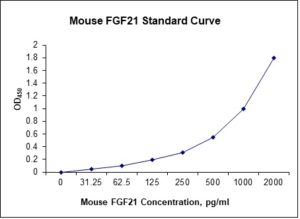Nori Mouse FGF21 ELISA Kit
$461.00 – $832.00
This ELISA kit is for quantification of FGF21 in mouse. This is a quick ELISA assay that reduces time to 50% compared to the conventional method, and the entire assay only takes 3 hours. This assay employs the quantitative sandwich enzyme immunoassay technique and uses biotin-streptavidin chemistry to improve the performance of the assays. An antibody specific for FGF21 has been pre-coated onto a microplate. Standards and samples are pipetted into the wells and any FGF21 present is bound by the immobilized antibody. After washing away any unbound substances, a detection antibody specific for FGF21 is added to the wells. Following wash to remove any unbound antibody reagent, a detection reagent is added. After intensive wash a substrate solution is added to the wells and color develops in proportion to the amount of FGF21 bound in the initial step. The color development is stopped, and the intensity of the color is measured.
Alternative names for FGF21: Fibroblast growth factor 21 (FGF21)
This product is for laboratory research use only not for diagnostic and therapeutic purposes or any other purposes.
- Description
- How Elisa Works
- Product Citations
- Reviews (0)
Description
Nori Mouse FGF21 ELISA Kit Summary
Alternative names for FGF21: Fibroblast growth factor 21 (FGF21)
| Assay Type | Solid Phase Sandwich ELISA |
| Format | 96-well Microplate or 96-Well Strip Microplate |
| Method of Detection | Colorimetric |
| Number of Targets Detected | 1 |
| Target Antigen Accession Number |
Q9JJN1 |
| Assay Length | 3 hours |
| Quantitative/Semiquantitative | Quantitative |
| Sample Type | Plasma, Serum, Cell Culture, Urine, Cell/Tissue Lysates, Synovial Fluid, BAL, |
| Recommended Sample Dilution (Plasma/Serum) | No dilution for sample <ULOQ; sufficient dilution for samples >ULOQ |
| Sensitivity | 6 pg/mL |
| Detection Range | 31.25-2000 pg/mL |
| Specificity | mouse FGF21 |
| Cross-Reactivity | < 0.5% cross-reactivity observed with available related molecules, < 50% cross-species reactivity observed with species tested. |
| Interference | No significant interference observed with available related molecules |
| Storage/Stability | 4 ºC for up to 6 months |
| Usage | For Laboratory Research Use Only. Not for diagnostic or therapeutic use. |
| Additional Notes | The kit allows for use in multiple experiments. |
Standard Curve
Kit Components
1. Pre-coated 96-well Microplate
2. Biotinylated Detection Antibody
3. Streptavidin-HRP Conjugate
4. Lyophilized Standards
5. TMB One-Step Substrate
6. Stop Solution
7. 20 x PBS
8. Assay Buffer
Other Materials Required but not Provided:
1. Microplate Reader capable of measuring absorption at 450 nm
2. Log-log graph paper or computer and software for ELISA data analysis
3. Precision pipettes (1-1000 µl)
4. Multi-channel pipettes (300 µl)
5. Distilled or deionized water
Protocol Outline
1. Prepare all reagents, samples and standards as instructed in the datasheet.
2. Add 100 µl of Standard or samples to each well and incubate 1 h at RT.
3. Add 100 µl of Working Detection Antibody to each well and incubate 1 h at RT.
4. Add 100 µl of Working Streptavidin-HRP to each well and incubate 20 min at RT.
5. Add 100 µl of Substrate to each well and incubate 5-30 min at RT.
6. Add 50 µl of Stop Solution to each well and read at 450 nm immediately.
Background:
Fibroblast growth factor 21 (FGF21) is a protein that in mammals is encoded by the FGF21 gene[1] and is a member of the fibroblast growth factor (FGF) family and specifically a member of the endocrine subfamily which includes FGF23 and FGF15/19. FGF21 is the primary endogenous agonist of the FGF21 receptor, which is composed of the co-receptors FGF receptor 1 and β-Klotho.[2] FGF21 is a hepatokine – i.e., a hormone secreted by the liver where FGF21 expression is regulated by PPARα and levels rise substantially with both fasting and consumption of ketogenic diets. FGF21 regulates simple sugar intake and preferences for sweet foods via signaling through FGF21 receptors in the paraventricular nucleus of the hypothalamus and correlates with reduced dopamine neurotransmission within the nucleus accumbens.[3] FGF21 stimulates glucose uptake in adipocytes but not in other cell types.[4] This effect is additive to the activity of insulin. FGF21 is specifically induced by mitochondrial HMGCS2 activity. The oxidized form of ketone bodies (acetoacetate) in a cultured medium also induced FGF21, possibly via a sirtuin 1 (SIRT1)-dependent mechanism.[5] In cows plasma FGF21 was nearly undetectable in late pregnancy, peaked at parturition, and then stabilized at lower, chronically elevated concentrations during early lactation. Serum FGF-21 levels were significantly increased in patients with type 2 diabetes mellitus (T2DM) which may indicate a role in the pathogenesis of T2DM. Elevated levels also correlate with liver fat content in non-alcoholic fatty liver disease[6] and positively correlate with BMI in Mouses suggesting obesity as a FGF21-resistant state.
References
- Nishimura T, et al. (2000). Biochimica et Biophysica Acta. 1492 (1): 203–6.
- BonDurant LD, Potthoff MJ (2018). Annu Rev Nutr. doi:1146/annurev-nutr-071816-064800.
- von Holstein-Rathlou S, et al. (2016). Cell Metabolism. 23 (2): 335–43.
- Kharitonenkov A, et al. (2005). The Journal of Clinical Investigation. 115 (6): 1627–35.
- Vilà-Brau A, et al. (2011). The Journal of Biological Chemistry. 286 (23): 20423–30.
- Yan H, et al. (2011). PLOS One. 6 (9): e24895.
Be the first to review “Nori Mouse FGF21 ELISA Kit”
You must be logged in to post a review.





























Reviews
There are no reviews yet.